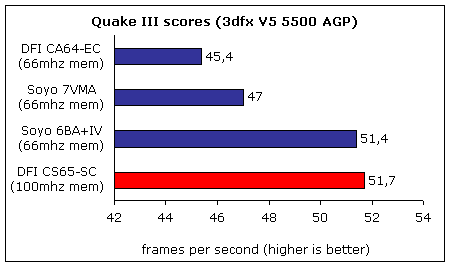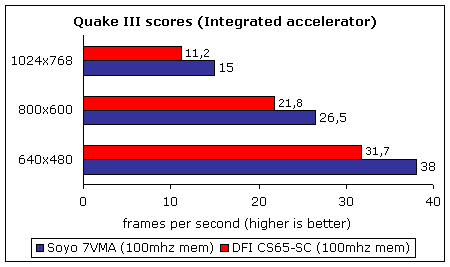 |
By taking a look at the Quake III performance chart we can see that the
tested board also offers top notch gaming performance. All in all we can
conclude that the CS65 SC is definitely a very fast board, mainly due to the
good design of the chipset.
Integrated Graphics
Performance
As we previously mentioned, the i815 has an integrated graphics
accelerator based on the Intel i752 graphics controller. Essentially, the i752
is a newer revision of the older i740 accelerator. In the case of the i815
chipset, the integrated accelerator is based on a unified memory architecture
(UMA), meaning that it shares the system's main memory with the graphics
subsystem. Of course memory bandwidth is also shared which definitely decreases
both system & 3D performance.
Business Performance degradation when
using the integrated accelerator instead of a standard accelerator is quite
small at low resolutions on low end processors (like our reference Celeron
566mhz). But if we use a faster processor (a PIII 700 or better), then the 2D
acceleration weakness of the integrated accelerator becomes more obvious.
Nevertheless the integrated 2D is more than enough for casual business
applications.
As for the 3D
performance, the following chart clearly indicates that even a low end processor
is held back by the i752. For this test we were able to get Soyo 7VMA scores
with a 100MHz memory bus without any stability problems. Both DFI and Soyo
scores are in the following chart without sound. We have to note that the Soyo
SY 7VMA is equipped with the VIA PM 133 chipset, which has a much better
integrated accelerator based on Savage4 3D engine and Savage 2000 2D core.

A faster processor
cannot help the i752 even at very low resolutions because it has a very poor
triangle setup throughput (it doesn't scale well with faster processors, and
since it doesn't support texture compression, low system memory bandwidth is a
another big bottleneck). On the other hand the PM 133 with it's Savage4
integrated engine is by far a more well rounded integrated solution (supports
much higher triangle setup, texture compression etc), specially with faster
processors.
The CS65 SC offers
adequate 2D acceleration but rather poor 3D performance. It is a viable solution
only for people working with business applications. Any serious gamer knows that
he/she has to pay for a real video card to get some good frame rates. Of course
you can go back to playing Quake I or other older games...without any
glitches.
